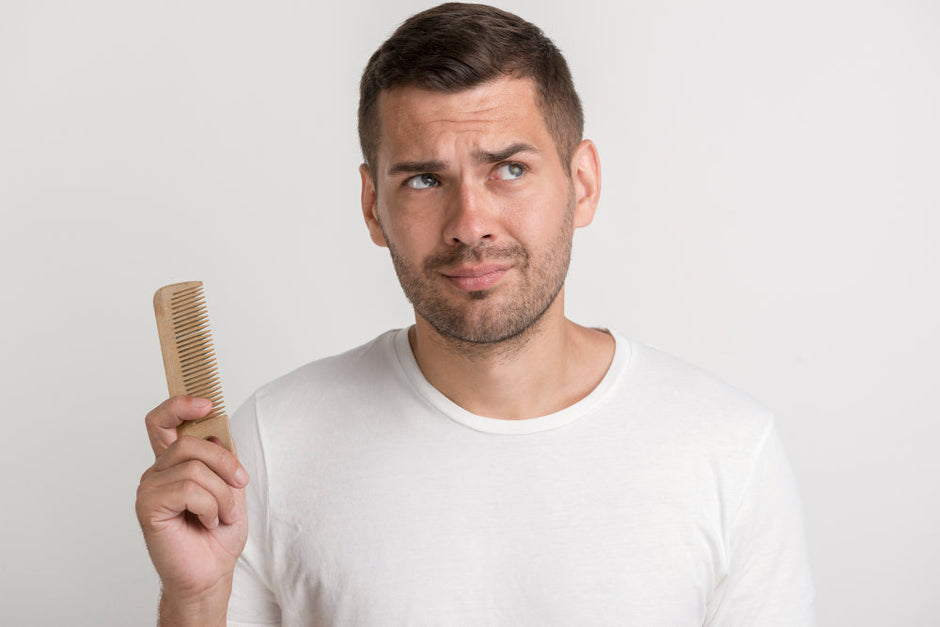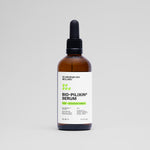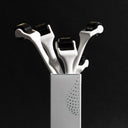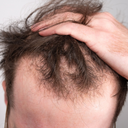Hair regrowth takes time, and results depend on the treatment you're using, your genetics, and overall health.
While some people notice changes in just a few months, others need a full year to see significant improvement.
If you're wondering how long it will take to grow your hair back, you're not alone.
Whether you're using minoxidil, finasteride, PRP, microneedling, or a hair transplant, each treatment follows its own timeline.
This breakdown will help you understand what to expect month by month, so you can track your progress and stay consistent with your routine.
Table of content
Understanding the hair growth cycle
Hair doesn’t grow overnight—it follows a natural cycle that affects how long it takes for new strands to appear. This cycle consists of four stages, and each one plays a role in hair regrowth.
Anagen (growth phase)
- This is the active phase where hair follicles produce new strands.
- It lasts between 2 to 7 years, depending on genetics.
- About 85-90% of your hair is in this phase at any given time.
- Treatments like minoxidil and PRP work by extending this phase, allowing more hair to grow.
Catagen (transition phase)
- This is a short, two-week phase where hair stops growing but remains attached to the follicle.
- The follicle begins to shrink and prepare for shedding.
- Only about 5% of your hair is in this phase at a time.
Telogen (resting phase)
- This phase lasts 3 to 4 months before hair naturally falls out.
- Around 10-15% of your hair is in this phase at any given time.
- Stress, illness, and poor nutrition can push more hair into this phase, leading to excessive shedding.
Exogen (shedding phase)
- This is when old hairs fall out to make room for new growth.
- Losing 50-100 hairs per day is normal, but excessive shedding may indicate an issue.
- Treatments like minoxidil can trigger temporary shedding before new, stronger hairs emerge.
Since hair grows in cycles, regrowth isn’t instant. Even with the best treatments, results take time. Understanding this process helps set realistic expectations.
As your leading source for hair health information over the past 4 years, we never compromise on accuracy. When it comes to your health, you deserve information you can truly rely on - and earning your trust is our top priority.
Here's how Scandinavian Biolabs ensures every piece of content meets the highest standards of accuracy and integrity:
- Credentialed Experts: Our reviewers are actively practicing doctors and medical researchers
- Stringent Reviews: Content undergoes rigorous editing by subject specialists and review by a practicing doctor.
- Evidence-Based: We rely on well-established research from trusted scientific sources like peer-reviewed journals and health authorities.
- Full Transparency: Our editorial standards, writer credentials, reviewer credentials, correction process, and funding are all publicly documented.
- Independent Voice: While we do promote products, we operate in a vacuum to business operations. Our main goal is just an unwavering commitment to providing medically-sound guidance.
You can count on Scandinavian Biolabs to consistently deliver the trustworthy health information you deserve. Read our Editorial Standards.
What's the normal hair growth rate?

Hair grows about half an inch per month, which adds up to six inches per year under normal conditions.
But this isn’t the same for everyone. Some people experience slower or faster growth due to genetics, age, and lifestyle habits. Here’s what influences the speed of hair growth:
- Genetics: Some people naturally grow hair faster than others.
- Age: Hair growth slows down as you get older.
- Nutrition: Deficiencies in iron, biotin, and vitamin D can slow growth.
- Scalp health: A clean, healthy scalp encourages faster hair growth.
- Stress levels: Chronic stress can push more hair into the shedding phase.
If you're using a treatment for hair loss, you might not see instant results because hair needs to go through its full cycle before new strands become visible.
Month-by-month hair regrowth timeline by treatment
Hair regrowth happens gradually. Some treatments show results faster than others, but patience is key. Here's what you can expect from month one to a full year.
Month 1-2: Early phase – minimal changes
In the first couple of months, most treatments won’t show obvious regrowth. Some may even trigger temporary shedding, which can be unsettling but is often a sign that the treatment is working. This happens because older, weaker hairs are pushed out to make way for new ones.
- Minoxidil: Shedding is common as the medication accelerates the hair cycle, pushing weak hairs out. The scalp may feel dry, itchy, or slightly irritated as it adjusts. Some people don’t notice any changes yet.
- Finasteride: No visible regrowth occurs yet, but internally, DHT levels start decreasing, which may slow down further hair loss. Some people experience a slight reduction in shedding, while others may still lose hair at the same rate.
- Hair transplant: Shock loss happens—many of the transplanted hairs fall out within the first month. This is completely normal and doesn’t mean the transplant failed. The scalp may remain red, tender, or slightly swollen during healing.
- PRP therapy: Some people notice reduced shedding within the first month, while others may not see any difference. The scalp might feel sensitive or tingly after treatment. New hair growth hasn’t started yet.
- Microneedling: The scalp may feel red, slightly sore, or flaky after the sessions, but this is temporary. Increased blood circulation helps prepare the follicles for growth, but visible changes aren’t expected yet.
- Low-level laser therapy (LLLT): No visible hair growth yet, but some people report their scalp feels healthier and less irritated.
Month 3-4: First signs of growth
By now, new hair may start emerging, but it will likely be fine, soft, and light-colored before thickening over time. Shedding should slow down for most treatments, and hair density may start to look slightly better in some areas.
- Minoxidil: Small vellus hairs (thin baby hairs) may appear where there was noticeable thinning. These hairs might not be strong yet, but their presence suggests that the treatment is beginning to work.
- Finasteride: Some people notice their existing hair feeling thicker, and shedding often decreases. However, regrowth in bald areas is still in its early stages.
- Hair transplant: New hairs begin emerging, but they are thin and may not grow evenly yet. The transplanted area should be healing well, and scalp redness usually fades.
- PRP therapy: Hair shafts may appear thicker and stronger, and shedding is often noticeably reduced. Some people report seeing new hair sprouting in thinning areas.
- Microneedling: More baby hairs may appear, particularly if microneedling is combined with another treatment like minoxidil.
- LLLT: Some users report improved hair texture, but major visible regrowth is still unlikely at this stage.
Month 5-6: Visible progress
This is when many people start to see more noticeable improvements. Hair is often thicker, stronger, and more evenly distributed. If shedding was an issue earlier, it should be much less frequent now.
- Minoxidil: Hair density begins to look fuller, and areas that previously had thinning may start filling in. However, some hairs may still be thinner than the rest.
- Finasteride: Thicker, stronger hair is more noticeable, especially at the crown and hairline. Shedding should have significantly reduced by this point.
- Hair transplant: The new hairs continue growing but may still be somewhat fine and soft. The hairline and overall coverage start appearing more natural.
- PRP therapy: Many people see noticeable thickening, particularly in areas that were previously thin. Hair looks fuller and healthier. Some may need an additional session to maintain progress.
- Microneedling: Hair continues to improve in texture and density. If combined with other treatments, results may be even more pronounced.
- LLLT: Many people using LLLT regularly report that their hair feels healthier, stronger, and less prone to breakage.
Month 7-9: More noticeable thickening
By this point, most treatments should be producing clear results. Hair is typically denser, thicker, and stronger, with fewer visible thinning areas.
- Minoxidil: The new hair is much thicker and darker, and overall coverage looks better. Some people find their results plateauing, while others continue to see gradual improvements.
- Finasteride: Hairline recession appears more stabilized, and the crown may look significantly fuller compared to the start. The quality of hair is generally better than before treatment.
- Hair transplant: The final texture and density start becoming more apparent. The transplanted hairs now blend naturally with the existing hair.
- PRP therapy: The maximum improvement is often reached around this time, with stronger, thicker hair. Some people opt for maintenance sessions to keep results going.
- Microneedling: Hair may have more volume and strength, with better scalp coverage. The impact is more noticeable in areas that were previously thinning.
- LLLT: Those who consistently use LLLT often see real regrowth at this stage, though results vary.
Month 10-12: Full results taking shape
This is the point where treatments show their final results. Hair is at its strongest, and further changes are often minimal.
- Minoxidil: Hair reaches its peak thickness and density, and bald patches are often less noticeable. Regular use is needed to maintain results—stopping treatment can lead to gradual hair loss again.
- Finasteride: Maximum regrowth is typically achieved, and the hairline and crown are at their best state. Continued use is required to maintain improvements.
- Hair transplant: The final look is now complete. The transplanted hairs should be fully grown, with natural thickness and texture. At this stage, styling and haircuts can be done without noticeable differences between transplanted and natural hair.
- PRP therapy: Many people notice fuller, stronger hair, but to maintain results, touch-up sessions may be recommended.
- Microneedling: Hair remains thick and strong, but results may start slowing down if sessions are stopped.
- LLLT: Those who stuck with the routine often report denser, healthier hair, though consistency is key for ongoing maintenance.
Other factors affecting hair regrowth

Hair regrowth isn’t just about the treatments you use. A lot of other things play a role in how well your hair grows, from your overall health to your daily habits. If you're not seeing the results you expected, some of these factors could be slowing things down.
Medical conditions
Underlying health conditions can interfere with hair regrowth, sometimes making it harder for treatments to work. If your hair loss is linked to a medical issue, addressing the root cause can help improve your results.
- Thyroid disorders: Both hypothyroidism and hyperthyroidism can cause hair thinning. If your thyroid levels are off, hair regrowth may be slower.
- Iron deficiency: Low iron levels can lead to excessive shedding, especially in women. This is one of the most common causes of hair thinning.
- Hormonal imbalances: Conditions like PCOS (polycystic ovary syndrome) can lead to increased shedding, especially in women.
- Autoimmune diseases: Alopecia areata and other autoimmune conditions can cause patchy hair loss. Some cases respond well to treatment, while others may require medical intervention.
- Chronic stress: Ongoing stress can push more hairs into the shedding phase, leading to increased hair loss over time.
Lifestyle & scalp care
Your daily habits and the way you care for your scalp can also influence how well your hair grows. Simple changes can sometimes make a big difference.
- Nutrition matters: Eating a well-balanced diet with plenty of protein, vitamins, and minerals can support hair regrowth. Hair is mostly made of keratin, so a diet lacking in protein can slow growth.
- Gentle hair care: Avoid harsh shampoos, frequent heat styling, and tight hairstyles that put stress on the scalp. These can lead to breakage and thinning over time.
- Scalp health is key: Keeping your scalp clean and hydrated can help create the right environment for hair growth. Build-up from oils and styling products can clog follicles, slowing down regrowth.
- Regular scalp massage: Massaging the scalp increases blood flow, which helps deliver more oxygen and nutrients to the hair follicles.
- Managing stress: Chronic stress raises cortisol levels, which has been linked to hair shedding. Simple stress-relieving activities like exercise, meditation, or deep breathing can help.
When to see a doctor
If you've been using a treatment consistently and haven't noticed any changes after six months, it might be time to check in with a specialist.
A doctor can help determine if there's an underlying issue affecting your hair regrowth. In some cases, adjusting your treatment plan or running a few tests can provide better insight into what’s going on.
Some signs that might mean it’s time to seek medical advice:
- Your hair loss suddenly worsens or becomes patchy.
- You experience itching, burning, or discomfort on your scalp.
- Your hair is falling out in clumps rather than gradually thinning.
- You've tried multiple treatments, but your hair still isn’t growing back.
A professional can recommend the right tests or treatments to address the problem and help get your hair back on track.
A holistic approach to your overall hair health

Hair regrowth isn’t just about using the right treatment—it’s also about creating the best conditions for your hair to thrive. A combination of medical treatments, lifestyle changes, and specialized hair care products can all play a role in supporting healthier, fuller hair.
One option that has been clinically tested is Bio-Pilixin Activation Serum, a plant-based formula developed with stem cell technology to help reduce hair loss and encourage regrowth. Unlike medications, it’s designed for daily, drug-free use and has shown promising results in trials.
In a study with 30 participants over 150 days, 77% noticed less hair loss after just 45 days, while 93% had a clinically tested reduction in hair loss by the end of the trial.
Additionally, 73% saw a measurable increase in hair density, with many first noticing less shedding in the shower within a few weeks of use.
The formula includes Capilia Longa®, a natural compound linked to improving hair density by up to 52% in individual studies.
It also contains Niacinamide, which helps strengthen hair by supporting keratin production, and Vanillyl Butyl Ether, a mild warming agent that improves blood circulation to hair follicles.
Since every scalp responds differently, results can vary. But for those looking for a non-medicated approach to hair regrowth, this serum could be a supportive addition to their routine.
Conclusion
Regrowing hair takes time, patience, and the right approach. Whether you're using medical treatments, making lifestyle changes, or adding supportive products to your routine, consistency is key.
Understanding how the hair growth cycle works can help manage expectations, while paying attention to factors like nutrition, stress, and scalp health can further support healthy regrowth.
If progress is slow or hair loss worsens, consulting a doctor can provide helpful insights.
At the end of the day, the best results come from a combination of science, care, and commitment.
References:
- https://www.sciencedirect.com/topics/medicine-and-dentistry/hair-growth
- https://pmc.ncbi.nlm.nih.gov/articles/PMC9917549/
- https://pubmed.ncbi.nlm.nih.gov/12196747/
- https://pubmed.ncbi.nlm.nih.gov/9777765/
- https://pmc.ncbi.nlm.nih.gov/articles/PMC5447335/
- https://pmc.ncbi.nlm.nih.gov/articles/PMC4622412/
- https://pmc.ncbi.nlm.nih.gov/articles/PMC8906269/






